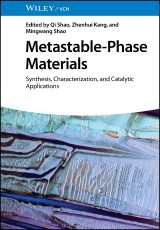Details

Metastable-Phase Materials
Synthesis, Characterization, and Catalytic Applications1. Aufl.
|
115,99 € |
|
| Verlag: | Wiley-VCH |
| Format: | |
| Veröffentl.: | 28.03.2024 |
| ISBN/EAN: | 9783527839810 |
| Sprache: | englisch |
| Anzahl Seiten: | 240 |
DRM-geschütztes eBook, Sie benötigen z.B. Adobe Digital Editions und eine Adobe ID zum Lesen.
Beschreibungen
<p><b>Discover the cutting-edge progress of a promising class of materials significant for use in energy technologies as catalysts</b></p> <p>Materials are said to be metastable-phases if they can retain their stability when subjected only to slight disturbances. Materials in metastable-phases can have very different properties from those in a state of equilibrium, and can perform very differently under conditions of experimentation, work, or industrial use. Metastable-phase materials are therefore a promising area of study in a variety of different fields, including cutting-edge industries.</p> <p><i>Metastable-Phase Materials</i> constitute a wide-ranging overview of these materials, their properties, and their applications. Beginning with an overall characterization of metastable-phase materials and their normal modes of synthesis, it characterizes the most important branch of metastable-phase materials and reviews a range of catalytic applications. The result is a critical contribution to materials science and catalytic chemistry with potentially far-reaching implications.</p> <p><i>Metastable-Phase Materials</i> readers will also find:</p> <ul> <li>Treatment of metastable-phase metal materials, 2D metastable-phase materials, and spin-dependent metastable-phase materials</li> <li>Detailed discussion of metastable-phase material applications in electrocatalysis, photocatalysis, thermalcatalysis, and more</li> <li>State-of-the-art technological applications in a myriad of areas</li> </ul> <p><i>Metastable-Phase Materials</i> are ideal for materials scientists, catalytic chemists, inorganic chemists, photochemists, electrochemists, organic chemists, and the libraries that serve these communities.</p>
<p>Foreword xi</p> <p>Preface xiii</p> <p><b>1 Introduction of the Metastable-Phase Materials 1<br /> </b><i>Qi Shao and Mingwang Shao</i></p> <p>1.1 Introduction 1</p> <p>1.2 What Are Metastable-Phase Materials? 1</p> <p>1.3 The Categories of Metastable-Phase Materials 2</p> <p>1.4 The Influence on Polymorphs of Materials 6</p> <p>1.5 The Wide Applications of Metastable-Phase Materials 8</p> <p>1.6 The Criterion for Stable-Phase and Metastable-Phase Materials 8</p> <p>References 10</p> <p><b>2 Synthetic Methodology 15<br /> </b><i>Qi Shao</i></p> <p>2.1 Introduction 15</p> <p>2.2 The Key for Synthesizing Metastable-Phase Materials 15</p> <p>2.3 The Synthetic Methods for Synthesizing Metastable-Phase Materials 16</p> <p>References 25</p> <p><b>3 Characterization 33<br /> </b><i>Qi Shao</i></p> <p>3.1 Introduction 33</p> <p>3.2 Characterizations 33</p> <p>3.3 How to Determine the Phase of Metastable-Phase 2D Metal Oxides 43</p> <p>References 45</p> <p><b>4 Metastable-Phase Metals 51<br /> </b><i>Qi Shao</i></p> <p>4.1 Introduction 51</p> <p>4.2 Noble Metals 51</p> <p>4.3 Non-noble Metals 60</p> <p>4.4 The Criterion to Determine the Stable-Phase and Metastable-Phase Metals 64</p> <p>References 66</p> <p><b>5 Metastable-Phase Oxide, Chalcogenide, Phosphide, and Boride Materials 71<br /> </b><i>Qi Shao</i></p> <p>5.1 Introduction 71</p> <p>5.2 Oxides 71</p> <p>5.3 Chalcogenides 76</p> <p>5.4 Others 78</p> <p>References 80</p> <p><b>6 Spin-Dependent Metastable-Phase Materials 85<br /> </b><i>Qi Shao</i></p> <p>6.1 Introduction 85</p> <p>6.2 Spin-Related Catalysis 85</p> <p>6.3 Spin-Related Catalysts for Alkaline OER 88</p> <p>6.4 Spin-Related Catalyst for Acidic OER 89</p> <p>References 90</p> <p><b>7 Crystallography, Design, and Synthesis of Two-Dimensional Metastable-Phase Oxides 93<br /> </b><i>Mingwang Shao and Qi Shao</i></p> <p>7.1 Introduction 93</p> <p>7.2 The Point Group, Crystal System, Crystal Lattice, and Space Groups of 2D Materials 93</p> <p>7.3 The Possible Crystal Structures and Chemical Formula of 2D Metal Oxides 100</p> <p>7.4 How to Prepare Metastable-Phase 2D Metal Oxides 119</p> <p>7.5 2D Metastable-Phase Noble Metal Oxides 120</p> <p>7.6 Metastable-Phase 2D Non-noble Metal Oxides 126</p> <p>7.7 The Covalent Bond Behavior in Metastable-Phase 1T Metal Oxides 129</p> <p>References 134</p> <p><b>8 Electrocatalysis 141<br /> </b><i>Qi Shao</i></p> <p>8.1 Introduction 141</p> <p>8.2 Several Typical Electrochemical Reactions 141</p> <p>8.3 Metastable-Phase Catalysts for Advanced Electrocatalysis 145</p> <p>References 167</p> <p><b>9 Photocatalysis 173<br /> </b><i>Mingwang Shao and Zhenhui Kang</i></p> <p>9.1 Introduction 173</p> <p>9.2 Fundamental Concepts of Photocatalysis 173</p> <p>9.3 Metastable-Phase Catalysts and Photocatalysis 177</p> <p>9.4 The Advantages and Disadvantages of Photocatalysis 182</p> <p>References 183</p> <p><b>10 Thermocatalysts 191<br /> </b><i>Qi Shao</i></p> <p>10.1 Introduction 191</p> <p>10.2 Several Typical Thermocatalytic Reactions 191</p> <p>10.3 Metastable-Phase Catalysts for Thermocatalysis 193</p> <p>References 201</p> <p>Summary and Outlook 207</p> <p>Index 209</p>
<p><b>Qi Shao, PhD,</b> is an associate professor at the College of Chemistry, Chemical Engineering and Materials Science, Soochow University, China. She received her PhD in applied physics from City University of Hong Kong in 2016.</p> <p><b>Zhenhui Kang, PhD,</b> is currently a professor at the Institute of Functional Nano & Soft Materials (FUNSOM) and the Jiangsu Key Laboratory for Carbon-Based Functional Materials and Devices in Soochow University, China.</p> <p><b>Mingwang Shao, PhD,</b> is a professor at the Institute of Functional Nano & Soft Materials (FUNSOM) and the Jiangsu Key Laboratory for Cabon-Based Functional Materials and Devices, Soochow University, China. He received his PhD from the University of Science and Technology of China in 2003.</p>
<p> <b>Discover the cutting-edge progress of a promising class of materials significant for use in energy technologies as catalysts</b> <p>Materials are said to be metastable-phases if they can retain their stability when subjected only to slight disturbances. Materials in metastable-phases can have very different properties from those in a state of equilibrium, and can perform very differently under conditions of experimentation, work, or industrial use. Metastable-phase materials are therefore a promising area of study in a variety of different fields, including cutting-edge industries. <p><i>Metastable-Phase Materials </i>constitutes a wide-ranging overview of these materials, their properties, and their applications. Beginning with an overall characterization of metastable-phase materials and their normal modes of synthesis, it characterizes the most important branch of metastable-phase materials and reviews a range of catalytic applications. The result is a critical contribution to materials science and catalytic chemistry with potentially far-reaching implications. <p><i>Metastable-Phase Materials </i>readers will also find: <ul><li>Treatment of metastable-phase metal materials, 2D metastable-phase materials, and spin-dependent metastable-phase materials</li><li>Detailed discussion of metastable-phase material applications in electrocatalysis, photocatalysis, thermalcatalysis, and more</li><li>State-of-the-art technological applications in a myriad of areas</li></ul> <p><i>Metastable-Phase Materials </i>is ideal for materials scientists, catalytic chemists, inorganic chemists, photochemists, electrochemists, organic chemists, and the libraries that serve these communities.


















